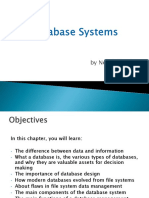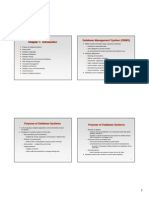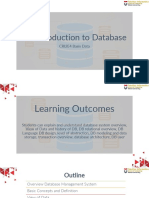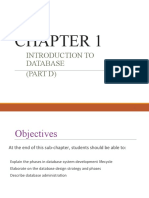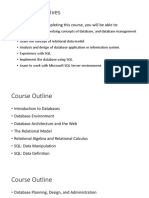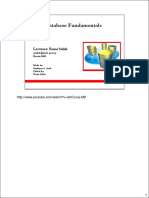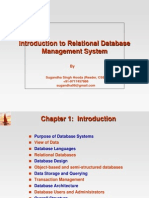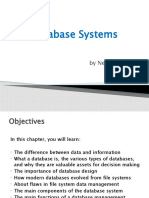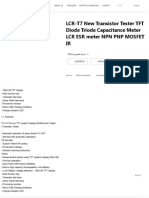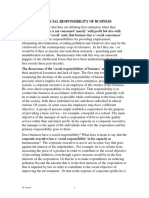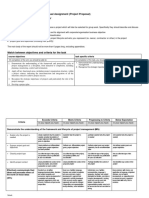Introduction to Database Systems
�Database and Database System
A database is a shared collection of
logically related data designed to meet the information needs of an organization. Database
Hardware
Components of a Database Systems
Software - DBMS
Users
2
�Database
The data in the database will be
expected to be both integrated and shared particularly on multi-user systems thought of as a unification of several otherwise distinct files, with any redundancy among these files eliminated
database may be shared among several different users
Integration - The database may be
Shared - individual pieces of data in the
�Hardware
These are secondary storage on which the
database physically resides, together with the associated I/O devices, device controllers etc.
�DBMS
Examples of DBMS Products
Oracle Informix Access DB2 Fox pro dBase SQL Server My SQL
�Typical Function of DBMS
Data storage, retrieval and update A user-accessible catalog Transaction support Concurrency and control services Recovery services Authorization services Support of data communication Integrity Services Services to promote data independence Utility services
6
�Users
Application Programmer - writes
programs that use the database Database Designers - designs conceptual and logical database Database Administrator (DBA) Data Administrator End - user - interacts with the system from an on-line terminal by using Query Languages etc.
7
�Data & Database Administration
Data Administrator a business manager
responsible for controlling the overall corporate data resources Database Administrator (DBA) - a technical person responsible for development of the total system
�Sample Applications
Student Records Banking Insurance Billing Systems e.g. Electricity, Phone ISPs Personnel Records Accounting Systems Reservation Systems e.g. Airline, Hotel Medical Records
9
�Advantages
Control of data redundancy Data consistency Multipurpose use of data Sharing of data, Enforcement of standards Economy of scale Balance conflicting user requirement Improved data accessibility and responsiveness Increased productivity Improved maintenance through data independence Increased concurrency Improved backup and recovery services.
10
�Disadvantages
Complexity Size Cost of DBMS Additional hardware costs Cost of conversion
11
�Database Architecture
External Level concerned with the way
users perceive the database
Conceptual Level concerned with
abstract representation of the database in its entirety
Internal Level concerned with the way
data is actually stored
12
�Architecture of Db System
External Level
Application 1
Application 2
Application 3
Logical Data Independence
Conceptual Level
DBMS
Physical Data Independence
Internal Level
Database
13
�Data Independence
Logical Data Independence users and user
programs are independent of logical structure of the database Physical Data Independence the separation of structural information about the data from the programs that manipulate and use the data i.e. the immunity of application programs to changes in the storage structure and access strategy
14
�Data Independence
Different applications will need different views of
the same data, so that if they are not interested in a part of the database, that part need not be included in their view. This feature is also important for controlling access to parts of database The DBA must have the freedom to change the storage structure or access strategy in response to changing requirements, without having to modify the existing applications
15
�Db Development Life Cycle
Database planning System definition Requirement collection and analysis Database design DBMS selection Application design Prototyping Implementation Data conversion and loading Testing Operational maintenance
16
�Database Design
Conceptual database design - the process of
constructing a model of the information used in an organization, independent of all physical considerations
Step 1 Build local conceptual data model for each user view
17
�Database Design
Logical database design for the relational
model - the process of constructing a model of the info used in an organization based on a specific data model, but independent of a particular DBMS and other physical considerations Step 2 Build and validate local data model for each user view Step 3 Build and validate global logical data model
18
�Database Design
Physical database design for relational
databases - the process of producing a description of the implementation of the database on secondary storage.
Step 4 Translate global data model for target DBMS Step 5 Design physical representation Step 6 Design security mechanisms Step 7 Monitor and tune the operational system
19
�Conceptual Database Design
Step 1 Build local conceptual data model for each user view
Identify entity types Identify relationship types Identify and associate attributes with entity or
relationship Determine attributes domains Determine candidate and primary key attributes Specialize/generalize entity types (optional step) Draw Entity-Relationship diagram Review local conceptual data model with user
20
�Logical Database Design for the Relational Model
Step 2 Build and validate local data model for each user view Map local conceptual data model to local logical data model Derive relations from local logical data model Validate model using normalization Validate model against user transactions Draw Entity-Relationship diagram Define integrity constraints Review local logical data model with user
21
�Logical Database Design for the Relational Model
Step 3 Build and validate global logical data model Merge local logical data models into global model Validate global data model Check for future growth Draw final Entity-Relationship diagram Review global logical data model with users
22
�Physical Database Design for Relational Databases
Step 4 Translate global data model for target DBMS Design base relations Design enterprise constraints for target DBMS
Step 5 Design physical representation Analyze transactions Choose file organizations Choose secondary indexes Consider the introduction of controlled redundancy Estimate disk space requirements
23
�Physical Database Design for Relational Databases
Step 6 Design security mechanisms
Design user views
Design access rules
Step 7 Monitor and tune the operational system
24


